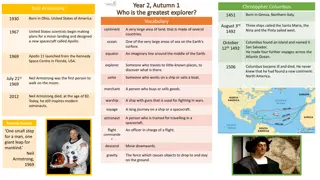
Exploring Musical Features of Mars Through Fanfare and Brass Instruments
Delve into the musical elements of Mars and its connection to fanfare and march, focusing on the role of brass instruments. Explore the significance of fanfare and march, listen to iconic pieces, and analyze their memorability. Learn about the Brass family, including how they produce sound and the evolution of brass instruments. Prepare for the next lesson by researching key musical terms and technical words related to the orchestra and brass instruments.
Download Presentation

Please find below an Image/Link to download the presentation.
The content on the website is provided AS IS for your information and personal use only. It may not be sold, licensed, or shared on other websites without obtaining consent from the author. If you encounter any issues during the download, it is possible that the publisher has removed the file from their server.
You are allowed to download the files provided on this website for personal or commercial use, subject to the condition that they are used lawfully. All files are the property of their respective owners.
The content on the website is provided AS IS for your information and personal use only. It may not be sold, licensed, or shared on other websites without obtaining consent from the author.
E N D
Presentation Transcript
Orchestra Explorers TOPIC Look at the musical features of Mars and connect it to the words fanfare and march Brass instruments play an important role when performing a fanfare. Read the information on the Brass family and facts about brass instruments. Read the definitions of both March and Fanfare Listen to two famous pieces and answer the question what makes them so memorable? Look back at your answers to the musical features in Mars: Bringer of War LESSON BRIEF NUMBER OF ACTIVITIES 5 short tasks HOW SHOULD I RECORD THE WORK I AM DOING? You can download the powerpoint, create a word or pages doc or complete with paper and pen, or create voice notes on your phone or create a blog site online. LEARNING FOCUS Listening skills and recall After the lesson you can visit this orchestra and its musicians, who talk more about the instruments we look at, by following this link; https://philharmonia.co.uk/resources/instruments/ Recap the meaning of both Fanfare and March and get someone to test your knowledge at home. INDEPENDENT RESEARCH KEY MUSICAL TERMS THAT WE WILL LOOK INTO ORCHESTRA, BRASS, FANFARE, MARCH, SLIDE, VALVES Look at some technical words and their meanings. NEXT LESSON WE WILL
Year 7 Music ORCHESTRA EXPLORERS
The Brass Family Making the Sound Brass instruments get their sound from the vibrations of the musician's lips. This works by the player putting their lips tightly into the mouthpiece and blowing. The vibration between the lips and mouthpiece causes the air to vibrate down the long brass tube. Musicians can vary the notes they play, the tone of the music, and the loudness by controlling the vibration of their lips. This takes a lot of practice to get right. Valves and Slides Brass instruments that are a fixed length can only make a few notes. This is the way all horns were for a long time. Then the slide and the valve were introduced. These allow the musician to change the length of the tube. They are each different in how they work. Valves When you look at all those tubes and curves in a trumpet, French horn, or tuba it can look almost like a mess of spaghetti. However, all those tubes help the instrument to make different sounds and notes. The buttons on these instruments are called valves. By pressing the valves, the player adds in additional length to the tube. Slide Another way to change the length of the tube is by using a slide. The slide is used in the trombone. By moving a long section of the tube in and out, the musician can change the length of the tube and, therefore, the notes. Since the tube can slide gradually, the musician can "slide" between notes giving a smooth sound.
Facts about Brass Instruments Horns have been used throughout history for various signals and fanfares due to their loud noise. The first horns were not made of brass, but used natural elements such as conch shells and animal horns. Trumpets were used as long ago as Ancient Egypt, however, it was in 1820 that the valve was invented and added to the trumpet design we know today. This allows the player to change the length of the tube that the air travels through and enables him to play more notes. Mutes are used to soften and lower the sound from a brass instrument. Mutes are put into the flared end at the bell. Different shapes of mutes can create different sounds. Most of the sound comes out the end of a brass instrument making the sound very directional. This is unlike many other instruments including woodwinds. There are two main types of trombones, the tenor trombone and the bass trombone. The bass trombone plays lower notes. The tenor trombone is what most people are talking about when they just say trombone. The tuba generally plays the lowest notes in the brass section. Some large bass tubas that are used in marching bands, called sousaphones, are partially made from fiberglass to make them lighter and easier to carry and march with. Curving the tubes of the brass instrument make them easier to hold and play. Even a small trumpet would be over 6 feet long if stretched out!
What is a March? What? Organised, rhythmic walk Who? Army, Military, Guards, School parades! Why? Boosts morale, Form of discipline, Sense of camaraderie What is a Fanfare? What? A fanfare is a short piece of music designed to call people s attention to the start of an event. Who? Army, Military, Royal court, public performances, weddings, funerals, school events, sporting events. Why? It s a way of communication and alerts you to something important that is about to happen.
A famous march https://www.youtube.com/watch?v=s3SZ5sIMY6o A famous fanfare https://www.youtube.com/watch?v=-hGEMdDF_jc Listen to both these examples what makes them so memorable?
In ancient Roman religion, Mars was the god of war. Holst composed this piece in anticipation of the outbreak of World War One. It s a march but an unusual one. https://www.bbc.co.uk/progr ammes/articles/14ZjT5yjnKQ RdKVsqrLzk1x/mars-from- the-planets-by-gustav-holst Normally a march has 4 beats in a bar so you can say "left, right, left, right" but Mars has 5 beats in a bar; tricky to march to! Let s listen to the piece Listen out for: The opening two harps, strings playing with the wood of the bow, timpani using very hard-headed sticks and the gong. There s also a solo from the euphonium. There are seven movements in The Planets, and each of these is a character piece, musically depicting the planet s mood, and that of its Roman god. Holst s love of astrology inspired him to write this work. What else can you hear? Musical Feature It sounded like the Bringer of War because . Q1: What is a March? Q2 Where are you likely to hear a March?





















